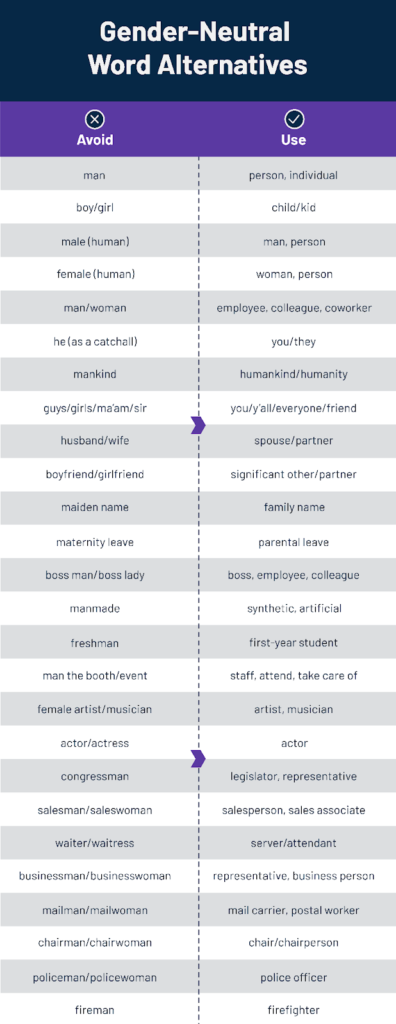Use Gender-Neutral Language in the Workplace
Every day, we make thousands of decisions. The average adult makes approximately 35,000 remotely conscious decisions per day. Many of these are about how we speak and the words we use. Language can create a significant impact on the message we want to communicate, collaboration and our workplace relationships. Using Gender-neutral language is inclusive and respectful of gender identities and groups.
When we interact with people, we should use language that makes people feel respected and included. It’s all in how we choose to use our words.
What is Gender-inclusive language?
According to the united nations, Gender-inclusive language is a way to speak and write that doesn’t discriminate against any particular sex or social gender identity and doesn’t create gender stereotypes. Gender equality at the workplace can be promoted by using gender-inclusive language for example, when referring to someone you don’t know, you should use “they” rather than using “he” or the “she” pronouns, or address a group with “hello everyone” instead of saying “hey guys.”
Why is caring about Gender-inclusive language important?
Historically, many jobs were traditionally for men or women and titled accordingly – policeman, fireman, stewardess, actress. However, now that both men and women are eligible to and are taking these jobs, gender-neutral alternatives become important – police officers, firefighters, flight attendants, and actors. This may seem simple, but it can help anyone envision themselves in these roles rather than being stuck with a stereotype.
Creating a work environment that fosters acceptance, support, and inclusivity is essential. According to research, 20 percent of non-binary employees believe they have lost a job because of their identity. Some of this discrimination comes from a place of misunderstanding, and the other comes from a place of non-tolerance.
What can you do?
How to use gender-neutral words isn’t something that we learnt in school, but swapping out some gendered words in your daily life can be simple and yet make a huge difference.
Essentially, when you use a gender-neutral term, you are making an effort to include everyone, no matter if you know their gender or not. For instance, a professional email traditionally may start with a form of address, like “Mr.” or “Mrs./Ms.” However, if you don’t know the recipient’s preferred pronouns, the one you select may not align with their gender identity. So when unsure, you can choose a gender-neutral alternative, like “Mx.,” or the person’s full name without a title. If you’re not familiar with the person you’re addressing, you can address their profession or group without noting their gender, such as “Dear Professor,” “Dear Members of the Board,” or “Dear Hiring Committee.”
Here is a list of gender-neutral pronouns/terms that you can adopt:

Let’s be the change that we expect from others
Any work initiative that starts from the self, brings quicker desired results. Breaking deeply ingrained habits will always be challenging and takes time, but everyone needs to change and adapt if we strive for a truly diverse and inclusive working environment. Using gender-neutral language is about questioning your assumptions, considering the sexist notions that contributed to these speech patterns in the first place, and doing your part to break the loop. The change adaptation by the leadership will set a good example and encourage others to join the initiative. To do this, leaders must be open and vocal about their commitment to gender inclusion and equality within the company. It’s about paying attention to signs of underlying sexism and consciously rejecting them, rather than dismissing them by saying, “it’s just an expression.”
Breaking deeply ingrained habits will always be challenging and take time, but everyone needs to change and adapt if we strive for a truly diverse and inclusive working environment. Using gender-neutral language is about questioning your pre-existing subconscious social conditioning considering the sexist notions that define these speech patterns in the first place, and doing your part to break the loop. It’s about paying attention to signs of underlying sexism and acting against them, rather than dismissing them and saying, “it’s just an expression.”



